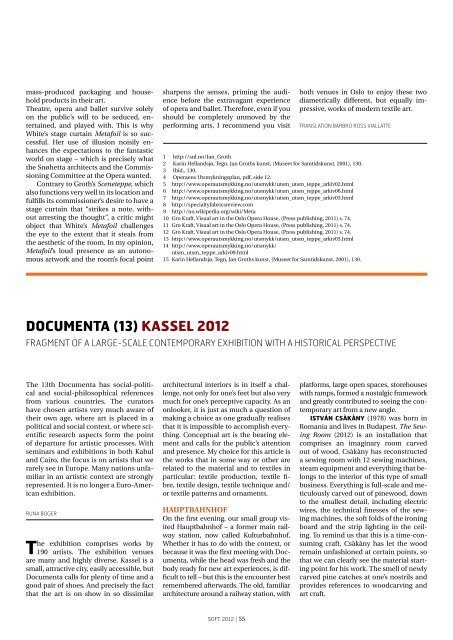2012 UTGITT AV NORSKE TEKSTILKUNSTNERE ... - SOFT galleri
2012 UTGITT AV NORSKE TEKSTILKUNSTNERE ... - SOFT galleri
2012 UTGITT AV NORSKE TEKSTILKUNSTNERE ... - SOFT galleri
You also want an ePaper? Increase the reach of your titles
YUMPU automatically turns print PDFs into web optimized ePapers that Google loves.
mass-produced packaging and household<br />
products in their art.<br />
Theatre, opera and ballet survive solely<br />
on the public’s will to be seduced, entertained,<br />
and played with. This is why<br />
White’s stage curtain Metafoil is so successful.<br />
Her use of illusion noisily enhances<br />
the expectations to the fantastic<br />
world on stage – which is precisely what<br />
the Snøhetta architects and the Commissioning<br />
Committee at the Opera wanted.<br />
Contrary to Groth’s Sceneteppe, which<br />
also functions very well in its location and<br />
fulfills its commissioner’s desire to have a<br />
stage curtain that “strikes a note, without<br />
arresting the thought”, a critic might<br />
object that White’s Metafoil challenges<br />
the eye to the extent that it steals from<br />
the aesthetic of the room. In my opinion,<br />
Metafoil’s loud presence as an autonomous<br />
artwork and the room’s focal point<br />
sharpens the senses, priming the audience<br />
before the extravagant experience<br />
of opera and ballet. Therefore, even if you<br />
should be completely unmoved by the<br />
performing arts, I recommend you visit<br />
dOCuMenTa (13) KaSSel <strong>2012</strong><br />
The 13th Documenta has social-political<br />
and social-philosophical references<br />
from various countries. The curators<br />
have chosen artists very much aware of<br />
their own age, where art is placed in a<br />
political and social context, or where scientific<br />
research aspects form the point<br />
of departure for artistic processes. With<br />
seminars and exhibitions in both Kabul<br />
and Cairo, the focus is on artists that we<br />
rarely see in Europe. Many nations unfamiliar<br />
in an artistic context are strongly<br />
represented. It is no longer a Euro-American<br />
exhibition.<br />
RUNA BOGER<br />
The exhibition comprises works by<br />
190 artists. The exhibition venues<br />
are many and highly diverse. Kassel is a<br />
small, attractive city, easily accessible, but<br />
Documenta calls for plenty of time and a<br />
good pair of shoes. And precisely the fact<br />
that the art is on show in so dissimilar<br />
soft <strong>2012</strong> | 55<br />
both venues in Oslo to enjoy these two<br />
diametrically different, but equally impressive,<br />
works of modern textile art.<br />
TRANSLATiON BARBRO ROSS ViALLATTE<br />
1 http://snl.no/Jan_Groth<br />
2 Karin Hellandsjø, Tegn, Jan Groths kunst, (Museet for Samtidskunst, 2001), 130.<br />
3 Ibid., 130.<br />
4 Operaens Utsmykningsplan, pdf, side 12.<br />
5 http://www.operautsmykking.no/utsmykk/utsm_utsm_teppe_arkiv02.html<br />
6 http://www.operautsmykking.no/utsmykk/utsm_utsm_teppe_arkiv06.html<br />
7 http://www.operautsmykking.no/utsmykk/utsm_utsm_teppe_arkiv03.html<br />
8 http://specialtyfabricsreview.com<br />
9 http://no.wikipedia.org/wiki/Meta<br />
10 Gro Kraft, Visual art in the Oslo Opera House, (Press publishing, 2011) s. 74.<br />
11 Gro Kraft, Visual art in the Oslo Opera House, (Press publishing, 2011) s. 74.<br />
12 Gro Kraft, Visual art in the Oslo Opera House, (Press publishing, 2011) s. 74.<br />
13 http://www.operautsmykking.no/utsmykk/utsm_utsm_teppe_arkiv03.html<br />
14 http://www.operautsmykking.no/utsmykk/<br />
utsm_utsm_teppe_arkiv09.html<br />
15 Karin Hellandsjø, Tegn, Jan Groths kunst, (Museet for Samtidskunst, 2001), 130.<br />
FRAGMENT OF A LARGE-ScALE cONTEMpORARy EXHiBiTiON WiTH A HiSTORicAL pERSpEcTiVE<br />
architectural interiors is in itself a challenge,<br />
not only for one’s feet but also very<br />
much for one’s perceptive capacity. As an<br />
onlooker, it is just as much a question of<br />
making a choice as one gradually realises<br />
that it is impossible to accomplish everything.<br />
Conceptual art is the bearing element<br />
and calls for the public’s attention<br />
and presence. My choice for this article is<br />
the works that in some way or other are<br />
related to the material and to textiles in<br />
particular: textile production, textile fibre,<br />
textile design, textile technique and/<br />
or textile patterns and ornaments.<br />
HauptbaHNHOf<br />
On the first evening, our small group visited<br />
Hauptbahnhof – a former main railway<br />
station, now called Kulturbahnhof.<br />
Whether it has to do with the context, or<br />
because it was the first meeting with Documenta,<br />
while the head was fresh and the<br />
body ready for new art experiences, is difficult<br />
to tell – but this is the encounter best<br />
remembered afterwards. The old, familiar<br />
architecture around a railway station, with<br />
platforms, large open spaces, storehouses<br />
with ramps, formed a nostalgic framework<br />
and greatly contributed to seeing the contemporary<br />
art from a new angle.<br />
iSTván CSàKàny (1978) was born in<br />
Romania and lives in Budapest. The Sewing<br />
Room (<strong>2012</strong>) is an installation that<br />
comprises an imaginary room carved<br />
out of wood. Csàkàny has reconstructed<br />
a sewing room with 12 sewing machines,<br />
steam equipment and everything that belongs<br />
to the interior of this type of small<br />
business. Everything is full-scale and meticulously<br />
carved out of pinewood, down<br />
to the smallest detail, including electric<br />
wires, the technical finesses of the sewing<br />
machines, the soft folds of the ironing<br />
board and the strip lighting in the ceiling.<br />
To remind us that this is a time-consuming<br />
craft, Csàkàny has let the wood<br />
remain unfashioned at certain points, so<br />
that we can clearly see the material starting<br />
point for his work. The smell of newly<br />
carved pine catches at one’s nostrils and<br />
provides references to woodcarving and<br />
art craft.



